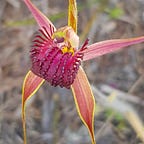Banksia Grandis and the Root Drinking Game
A Species a Day 2, 26 October 2020, Banksia Grandis in the Lowlands Reserve
On bushwalks, are you overwhelmed with the names of the plants? No? A quick way for you to experience this is to go for a walk with a wildflower enthusiast, and they be like , “ oooh Banksia grandis, Spyridium globulosa, Adenanthos cuneatus….”, in just about every tiny patch of bush even if it’s just in a roadside ditch somewhere..Its similar to going on country with Noongar elders, as they recall much of their knowledge from cues in the land, the wisdom of the songlines endures.
Having decided to just feature one species a day was so hard for me today, with all the plants yelling “Choose me, choose me!”
Banksia grandis are susceptible to dieback. So having healthy banksia in bushland , can be an indicator that dieback hasn’t yet done its worst. The symptoms of dieback are similar to drought, because the dieback organism eats away little holes in the roots of plants. See picture to the left where zoospore is eating a hole in the root.
A fun way to show people this is to get them to play the root drinking game. You give them each a glass of water and a straw, and the challenge is to be first to finish the water. Unbeknownst to your players, you have previously pricked holes in some of the straws but not others. Once you have played the root drinking game, you will never forget how dieback makes it difficult for trees to suck water up through their roots. Seeing the dismay of your unsuspecting players who have leaky straws is memorable — I’m sure you can also think of ways to make the game even more fun. Do you think I should try this out as a Halloween game at our next bookclub?
The Noongars , of course, had the best use of Mangaitch (banksia grandis flowers). It is heavy in nectar and makes a wonderfully sweet drink when soaked and sometimes fermented in water. Daisy Bates reported that the Aboriginal people came from far and wide when the boolgala (or biara banksia) were in flower to join in festivals and jolly ups centred around drinking the sweet nectar. An earlier settler also describes the Noongars of the South West soaking Mangaitch to make an “exhilarating” drink which produced “excessive volubility”.
More sedately, Vivienne Hansen and John Horsfall state that the sweet liquid from Banksia grandis was also used medicinally as a cough mixture and to soothe a sore throat.Also referenced by Hansen and Horsfall is:Moore, G.F., Diary of Ten Years Eventful Life of an Early Settler in Western Australia.This is the 1830s diary of an Irish barrister who emigrated to Western Australia. The diary has many references to Banksias, being used as a sweet drink, and for transporting fire. Moore states that N-yogulang means to steep in water — as in preparing banksia flowers in water. He describes the preparation of Mangyt (Mangaitch) in a hole in the ground around which the Noongar people would sit and dunk fine fibrous material in the infusion using it like a sponge to suck the sweet drink.
Both Daisy Bates and Moore mention Noongar lore about mother Sun, Nanga, who lights her banksia cone firebrand before dawn and travels across the sky from east to west before extinguishing her firebrand after sunset.
The Banksia grandis near the coast in the Lowlands Reserve are very resilient and low growing, pruned by the wind. Banksia grandis can grow to 10 metres elsewhere, eg on the sides of the Albany Highway, but in the Lowlands Reserve even some of the old specimens are no more than 60 cm tall. First flowering in Banksia grandis occurs after 20 years from plants grown from seed, or sometimes at 10 years old in the case of banksias growing from lignotubers.
Banksia cones can have thousands of inflorescences but then only produce a few follicles and a handful of seeds, despite the efforts of the pollinators. Although beloved by bees and other insects, the sturdy flowers allow for heavy bird pollinators and the low growing blooms are easily accessed by small mammals pollinators such as honey and pygmy possums. You can occasionally see these tiny possums feeding at dusk.
Lowlands Reserve is on Minang Boodja — country. I celebrate the resilience, culture and capacity of the traditional owners, the Minang Noongar people of the Wagyl Kaip region.
I’m fundraising for Bush Heritage #groundworkchallenge . To join my team or donate go to https://www.groundworkchallenge.org.au/fundraisers/sheilamurray/2020?fbclid=IwAR2HbNn0YsCCc3tiSK-_lbF5xLsssaD8wjGHaUwVYrRqYxM-kdJkijoj2N0
Follow me on instagram and twitter @lowlandsbeach . https://www.instagram.com/lowlandsbeach/
https://twitter.com/lowlandsbeach
https://www.linkedin.com/in/sheila-murray-2730491bb/
